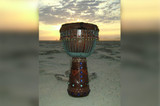Udu Drum History and Technique
African music and drumming has long since utilized different household and non-musical items in order to produce the different sounds, tones and instruments typically thought of as traditionally African. Percussion plays a dominant role in African culture and music, and the instruments used as drums, shakers and other hand percussion instruments were adaptations of materials and items found in and around tribal villages. These instruments have evolved through the years into many of the different percussion instruments known and loved today.
The Udu drum is a prime example of a household object that was also used as an instrument. This unique, pot-shaped instrument can be found throughout African villages. It originated from the Igbo women of Nigeria who used the clay pots to store food, carry water and even for beekeeping. Women were the only members of these villages allowed to create the important pottery, or even find the clay needed for their creations, as it was believed a man would become impotent if he had anything to do with the creation of the Udu.
Because of the connection between the divine feminine and the female members of the villages, the Udu became an important part of rituals and ceremonies presented to honor their female deities. It was from these rites that the Udu developed into a percussion instrument, and its fame and popularity has grown ever since.
Playing the Udu takes skill and practice, as it is able to produce different sounds at different levels. The instrument itself is pot-shaped, with a hole on its side that is smaller than the palm of the hand. It is from this hole that most of the sounds are played, whether by cupping the handover the hole as it is slapped, or drumming the fingers near the hole, producing higher, melodic tones. To play the Udu, sit with the instrument in your lap, tilting the neck slightly. Spread your fingers wide apart and strike the hole with the palm. For higher notes from the Udu, using the same hand position, strike the palm against the opening at the neck of the Udu. The Udu is actually able to produce sounds in a one octave range, making it one of the more unique percussion instruments with an African heritage. In addition to striking the instrument, the sides of the Udu are also used for their percussion accentuation, giving a raspy sound when brushed against by the hand.
Incorporating different sounds and instruments into a performance or drum circle keeps the music fun and the other players interested. The rich history of the Udu and its sacred connection to the divine feminine may add a new layer to the songs and rhythms played, and even create a new feel to the music it accompanies.
Recent Posts
-
What is the Best Size Djembe for Beginners?
If you're new to the world of percussion and interested in learning the djembe, you're in for a t …16th Jul 2024 -
The Benefits of Becoming a Drumming Teacher: Transforming Passion into Profession
Why become a drumming teacher? Becoming a drumming teacher is an excellent way to share your pas …22nd May 2024 -
What Makes the Djembe Drum a Spiritual Instrument in African Music?
Origin and history of the Djembe drum The Djembe drum originates from West Africa and holds sign …16th May 2024



